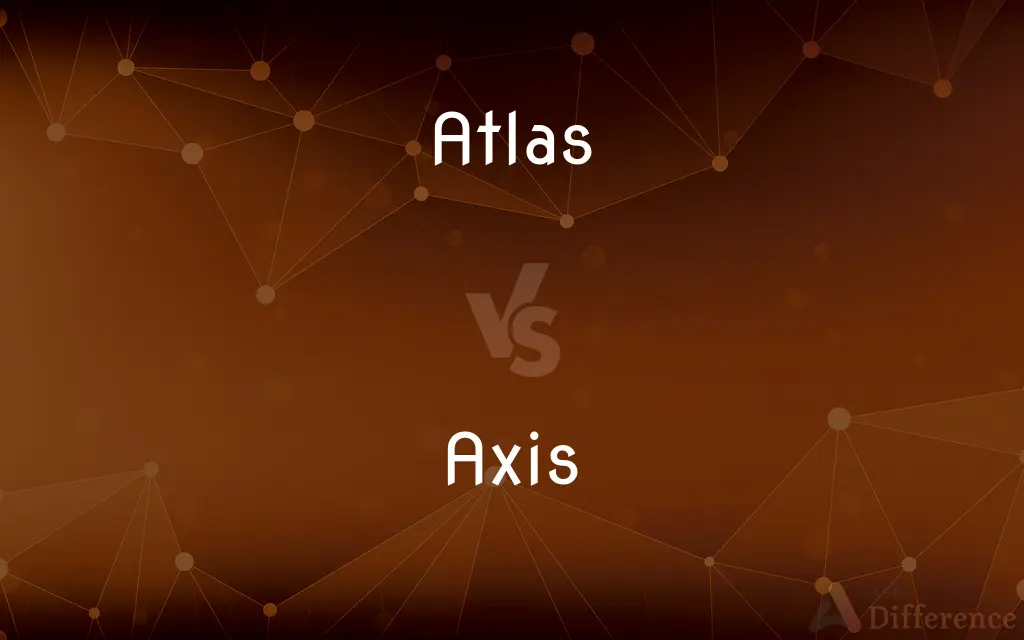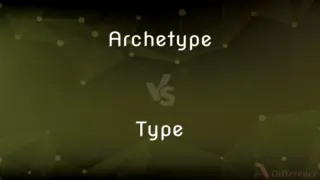Atlas vs. Axis — What's the Difference?
By Urooj Arif & Fiza Rafique — Updated on April 5, 2024
The atlas (C1) supports the skull and enables nodding movements, while the axis (C2) allows for the rotation of the head.

Difference Between Atlas and Axis
Table of Contents
ADVERTISEMENT
Key Differences
The atlas, or the first cervical vertebra (C1), is unique because it lacks a body and a spinous process, which distinguishes it from other vertebrae. It is designed to support the skull, allowing for the nodding motion of the head. On the other hand, the axis, or the second cervical vertebra (C2), is characterized by the odontoid process (dens) that protrudes upward, locking into the atlas to facilitate head rotation.
Both the atlas and axis are crucial for head movement, but they serve different functions. The atlas allows for up and down movement, as in nodding "yes," due to its ring-like structure and articulation with the occipital bone of the skull. Whereas the axis permits the turning of the head from side to side, as in shaking the head "no," thanks to the odontoid process that acts as a pivot.
In terms of anatomical structure, the atlas is more flat and ring-like, designed to bear the weight of the skull. The axis, however, has a more typical vertebrae structure but is distinguished by the odontoid process, which is not found in any other vertebra. This structural difference underlines their specialized functions in head mobility.
The ligamentous structures surrounding these vertebrae also differ. The transverse ligament of the atlas holds the dens of the axis against the anterior arch of the atlas, which is critical for stability during rotation. Meanwhile, the axis has robust articulations with both the atlas above and the third cervical vertebra below, providing a strong pivot point.
Lastly, injuries to the atlas and axis are both serious but have different implications due to their unique structures and functions. An injury to the atlas might severely affect the support of the skull, whereas damage to the axis could impair rotational movement of the head, highlighting the specialized yet critical roles they play in cervical spine function and head mobility.
ADVERTISEMENT
Comparison Chart
Main Function
Supports the skull for nodding movements
Allows head rotation
Unique Structure
Ring-like, lacks a body and spinous process
Odontoid process (dens) for rotation
Movement Allowed
Nodding "yes" (up and down)
Shaking head "no" (side to side)
Ligamentous Structure
Transverse ligament holds it to the axis
Articulates robustly with C1 and C3
Injury Implications
Affects skull support
Impairs head rotation
Compare with Definitions
Atlas
The atlas is the first cervical vertebra supporting the skull.
The atlas allows for the nodding motion of the head.
Axis
The axis is the second cervical vertebra with a distinctive odontoid process.
The odontoid process of the axis enables head rotation.
Atlas
It is characterized by its ring-like shape and absence of a body.
Injuries to the atlas can severely affect neck mobility.
Axis
Its odontoid process acts as a pivot for the atlas.
The axis's odontoid process is a critical element in neck mobility.
Atlas
It lacks a spinous process, unlike other vertebrae.
The unique structure of the atlas supports the skull's weight.
Axis
It allows for the rotation of the head, facilitating the "no" motion.
Damage to the axis can impair one's ability to turn their head.
Atlas
The atlas articulates with the occipital bone of the skull.
This articulation facilitates the yes motion.
Axis
The axis has a stronger body compared to the atlas.
The robust structure of the axis supports the atlas and skull above.
Atlas
The atlas plays a critical role in the upper cervical spine's mobility.
Dysfunction in the atlas can lead to neck pain.
Axis
Injuries to the axis can significantly affect neck function.
Fractures of the axis require immediate medical attention.
Atlas
An atlas is a collection of maps; it is typically a bundle of maps of Earth or a region of Earth. Atlases have traditionally been bound into book form, but today many atlases are in multimedia formats.
Axis
The second cervical vertebra on which the head turns.
Atlas
Greek Mythology A Titan condemned by Zeus to support the heavens upon his shoulders.
Axis
A straight line about which a body or geometric object rotates or may be conceived to rotate.
Atlas
Atlas A person who supports a great burden.
Axis
An unlimited line, half-line, or line segment serving to orient a space or a geometric object, especially a line about which the object is symmetric.
Atlas
A book or bound collection of maps, sometimes with supplementary illustrations and graphic analyses.
Axis
A reference line from which distances or angles are measured in a coordinate system.
Atlas
A volume of tables, charts, or plates that systematically illustrates a particular subject
An anatomical atlas.
Axis
A center line to which parts of a structure or body may be referred.
Atlas
A large size of drawing paper, measuring 26 × 33 or 26 × 34 inches.
Axis
An imaginary line to which elements of a work of art, such as a picture, are referred for measurement or symmetry.
Atlas
Pl. at·lan·tes (ăt-lăntēz) Architecture A standing or kneeling figure of a man used as a supporting column, as for an entablature or balcony. Also called telamon.
Axis
Any of various central structures, such as the spinal column, or standard abstract lines used as a positional referent.
Atlas
(Anatomy) The top or first cervical vertebra of the neck, which supports the skull.
Axis
(Botany) The main stem or central part about which organs or plant parts such as branches are arranged.
Atlas
A bound collection of maps often including tables, illustrations or other text.
Axis
One of three mutually perpendicular lines that define the orientation of an aircraft, with one being along its direction of travel and the other two being perpendicular to the direction of travel.
Atlas
A bound collection of tables, illustrations etc. on any given subject.
Axis
A line through the optical center of a lens that is perpendicular to both its surfaces.
Atlas
A detailed visual conspectus of something of great and multi-faceted complexity, with its elements splayed so as to be presented in as discrete a manner as possible whilst retaining a realistic view of the whole.
Axis
One of three or four imaginary lines used to define the faces of a crystal and the position of its atoms.
Atlas
A family of coordinate charts that cover a manifold.
Axis
An alliance of powers, such as nations, to promote mutual interests and policies.
Atlas
(anatomy) The uppermost vertebra of the cervical spine in the neck in humans and some other animals.
Axis
Axis The alliance of Germany and Italy in 1936, later including Japan and other nations, that opposed the Allies in World War II.
Atlas
One who supports a heavy burden; mainstay.
Axis
(geometry) An imaginary line around which an object spins (an axis of rotation) or is symmetrically arranged (an axis of symmetry).
The Earth rotates once a day on its axis
Atlas
(architecture) A figure of a man used as a column.
Axis
(mathematics) A fixed one-dimensional figure, such as a line or arc, with an origin and orientation and such that its points are in one-to-one correspondence with a set of numbers; an axis forms part of the basis of a space or is used to position and locate data in a graph (a coordinate axis)
Atlas
(paper) A sheet of paper measuring 26 inches by 34 inches.
Axis
(skeleton) The second cervical vertebra of the spine
Atlas
(historical) A rich satin fabric.
Axis
(anatomy) An imaginary, visualized plane separating two morphologically similar parts of an organism
Atlas
One who sustains a great burden.
Axis
(psychiatry) A form of classification and descriptions of mental disorders or disabilities used in manuals such as the DSM (Diagnostic and Statistical Manual of Mental Disorders)
Atlas
The first vertebra of the neck, articulating immediately with the skull, thus sustaining the globe of the head, whence the name.
Axis
(botany) The main stem or central part about which organs or plant parts such as branches are arranged
Atlas
A collection of maps in a volume
Axis
(military) An alliance or coalition.
Atlas
A volume of plates illustrating any subject.
Axis
A deer native to Asia, of species Axis axis.
Atlas
A work in which subjects are exhibited in a tabular from or arrangement; as, an historical atlas.
Axis
The spotted deer (Cervus axis or Axis maculata) of India, where it is called hog deer and parrah (Moorish name).
Atlas
A large, square folio, resembling a volume of maps; - called also atlas folio.
Axis
A straight line, real or imaginary, passing through a body, on which it revolves, or may be supposed to revolve; a line passing through a body or system around which the parts are symmetrically arranged.
Atlas
A rich kind of satin manufactured in India.
Axis
A straight line with respect to which the different parts of a magnitude are symmetrically arranged; as, the axis of a cylinder, i. e., the axis of a cone, that is, the straight line joining the vertex and the center of the base; the axis of a circle, any straight line passing through the center.
Atlas
(Greek mythology) a Titan who was forced by Zeus to bear the sky on his shoulders
Axis
The stem; the central part, or longitudinal support, on which organs or parts are arranged; the central line of any body.
Atlas
A collection of maps in book form
Axis
The second vertebra of the neck, or vertebra dentata.
Atlas
The 1st cervical vertebra
Axis
One of several imaginary lines, assumed in describing the position of the planes by which a crystal is bounded.
Atlas
A figure of a man used as a supporting column
Axis
The primary or secondary central line of any design.
Axis
A straight line through a body or figure that satisfies certain conditions
Axis
The center around which something rotates
Axis
The main stem or central part about which plant organs or plant parts such as branches are arranged
Axis
In World War II the alliance of Germany and Italy in 1936 which later included Japan and other nations;
The Axis opposed the Allies in World War II
Axis
A group of countries in special alliance
Axis
The 2nd cervical vertebra; serves as a pivot for turning the head
Common Curiosities
What is the atlas vertebra?
The atlas is the first cervical vertebra, supporting the skull and enabling nodding movements.
What is the odontoid process?
It's a projection from the axis that fits into the atlas, allowing head rotation.
Can you rotate your head without the axis?
No, the axis's odontoid process is essential for head rotation.
What makes the atlas unique among vertebrae?
Its ring-like structure and lack of a body and spinous process.
How does the atlas allow for head movement?
The atlas facilitates nodding movements by articulating with the skull.
How do the atlas and axis work together?
They enable head movements: nodding by the atlas and rotation by the axis.
How do injuries to the axis affect head movement?
Injuries can impair rotational movement, affecting the ability to turn the head.
What distinguishes the axis from other vertebrae?
The axis features an odontoid process, allowing for head rotation.
What happens if the atlas is injured?
An injury can affect neck mobility and the support of the skull.
What role does the odontoid process play in neck mobility?
It acts as a pivot for head rotation.
What is the significance of the articulation between the atlas and the skull?
This articulation allows for the up and down nodding motion of the head.
What ligaments are important for the atlas and axis?
The transverse ligament of the atlas and the ligaments connecting the axis to surrounding vertebrae are vital for stability.
Are the atlas and axis prone to specific injuries?
Yes, due to their crucial roles and unique structures, they're susceptible to injuries affecting head and neck mobility.
How is the axis structurally different from the atlas?
The axis has an odontoid process and a more typical vertebrae structure, unlike the atlas's ring-like form.
Can the atlas and axis affect spinal health?
Yes, their function and health are crucial for overall cervical spine stability and mobility.
Share Your Discovery

Previous Comparison
Archetype vs. Type
Next Comparison
Outbid vs. OverbidAuthor Spotlight
Written by
Urooj ArifUrooj is a skilled content writer at Ask Difference, known for her exceptional ability to simplify complex topics into engaging and informative content. With a passion for research and a flair for clear, concise writing, she consistently delivers articles that resonate with our diverse audience.
Co-written by
Fiza RafiqueFiza Rafique is a skilled content writer at AskDifference.com, where she meticulously refines and enhances written pieces. Drawing from her vast editorial expertise, Fiza ensures clarity, accuracy, and precision in every article. Passionate about language, she continually seeks to elevate the quality of content for readers worldwide.















































